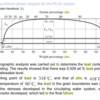Here is a little more info for the discussion.
Off-Specification Alloy
All alloys may become contaminated or lose composition, but there is a greater chance with alloy made from secondary materials due to their narrower impurity margins.
Only an unscrupulous supplier would sell off spec. material and only a misguided die caster would purchase it. Not only will the material have inferior mechanical properties and be likely to fail in service, but it will also prove to be more difficult to cast thus resulting in higher scrap rates. Additionally drossing losses will be significantly higher.
By using such material, the die caster will probably finish with fewer castings per ton of metal purchased. Production will also take up more machine time, so that the "cheap" material costs him more in the long run.
The increased chance of part failure could cost him his reputation, his customer base and his market. Remember that product liability laws make a manufacturer responsible years after the parts have left his shop. Should a failed component be found to be out of specification for chemistry, then the manufacturer will be held at least partly responsible, even if the alloy composition had nothing to do with the failure.
How are off-spec. and secondary alloy associated?
Secondary zinc alloys, which are properly produced from carefully separated scrap material, are not inferior alloys. However, many secondary alloys, which are imported into North America, are often not produced with as much care as necessary.
Due to the impurities, which are generally found in scrap materials, it is significantly more difficult to produce in spec. alloy ingots from secondary materials than from SHG or recycled materials. Tin plating often used on electronic castings and pressed in leaded bronze bushings are just two examples of typical impurities. If too many impurities are allowed to enter the melt, the resulting alloy will be out of spec.
Particular attention must be paid to the very strict maximums which the spec. places on Lead (Pb), Cadmium (Cd) and Tin (Sn). The reason for this is not visible to the naked eye until it's too late. These three elements can cause intergranular corrosion in the Zamak and ZA alloys when any of these elements is present above the ASTM specification.
What is lntergranular Corrosion?
When a zinc alloy solidifies, the material's matrix forms microscopic grains. As the name implies, Intergranular Corrosion is corrosion which occurs at the boundaries between the grains.
Intergranular Corrosion can cause catastrophic failure in stressed applications. In fact, after only 90 days in a humidity cabinet at 203 F (95° C), zinc castings containing only marginally out of Spec. Pb, Cd or, Sn will lose most of their impact strength. Catastrophic failure caused by Intergranular Corrosion may occur very suddenly without any prior notice.
A low magnesium content in a zinc casting alloy can also promote the rate of intergranular corrosion when the levels of Pb, Cd and Sn are at or even near the maximums specified.
What happens when other alloy constituents are out of spec.?
While intergranular corrosion is certainly the most serious problem with off grade zinc alloy, out of spec. quantities of other elements such as aluminum, magnesium, and copper can also affect material performance.
Additionally out of spec. alloy not only affects the operations of the finished components, but it can also make a die caster very uncompetitive. Poor fluidity, high dross and poor surface finish are all attributes of "out of Spec. material".
However, in spec. material that only marginally meets the casting specification limits can also cause some variations in certain casting parameters such as fluidity. The ASTM specifications denote only the maximum tolerance permitted for use. Many alloyers will endeavor to hold these tolerances much tighter, especially in alloys produced from primary zinc, thus reducing variations in casting parameters.
After all, the true test of a material's cost is how many good components are produced out of a ton of metal. A 1% increase in production of "good" castings is worth much more than a 1% reduction in metal cost.








